Charlotte Hollis lives by herself in a big villa and is persecuted by nightmares about the murder of her lover years before. She wants to keep her home from being taken away from her and asks her cousin Miriam and Dr. Drew Baylis to help her. They move into the villa and plan on driving Charlotte crazy and dispossessing her of all her goods. Aldrich repeats the clash of actresses in What Ever Happened to Baby Jane? for a sort of sequel to the preceding film, which was also based on a novel by Henry Farrell. “I wanted to re-team Davis and Crawford. Then Miss Crawford fell ill and was replaced by Olivia de Havilland. [...] Obviously the ideal candidates would have been Vivien Leigh and Katherine Hepburn. Now it’s not necessary that it should become a matter of public record why Davis didn’t want either of those ladies. It is fair to say however that it had nothing to do with their talent. But there are deep-steated personal and historical reasons why she didn’t want them. I won’t say that Olivia was third choice, but she was the first choice that was acceptable.” (R. Aldrich)
Biography
film director

Robert Aldrich
Robert Aldrich (Cranston, Rhode Island, 1918 - Los Angeles, 1983) was borninto a family of bankers; after finishing his university degree he decided to move to Hollywood and begin a career in the movies. He first worked as assistant director for filmmakers like Jean Renoir, Abraham Polonsky, Joseph Losey and Charlie Chaplin, and debuted as a director in 1953 with the MGM film The Big Leaguer, about the world of baseball. His film World For Ransom (1954) began to trace the outline of his poetics, a brutal realism which pairs a fight for survival and exaltation of male virility before the background of a violent, petty society. That same year he tried his hand at westerns with Apache and Vera Cruz, both starring Burt Lancaster, the first of a series of Aldrich male role models later incarnated by actors like Charles Bronson, Jack Palance, Ernest Borgnine and Burt Reynolds. His next film, Kiss Me Deadly (1955), which was praised by “Cahiers du Cinéma,” marked the beginning of his critical success, as Aldrich concentrated on typical hard boiled themes, to which he returned many years later with Hustle (1975). The Big Knife (1955), the first film Aldrich made with Associates & Aldrich – the independent production company which produced the majority of his films – was a bitter tirade against Hollywood and the world of entertainment, arguments which he brought up once again in The Legend of Lylah Clare (1968) and The Killing of Sister George (1968). The relationship between tyrannical system and individual was the central theme of Attack! (1956), a digression into war films, to which Aldrich frequently returned, with Ten Seconds to Hell (1959), The Dirty Dozen (1967), his greatest public success, and Too Late the Hero (1969), which repeated the same “patrol movie” formula of his preceding, successful film. Between 1962 and 1964 he directed Bette Davis in What Ever Happened to Baby Jane? and Hush… Hush, Sweet Charlotte (1965), films which combined thriller, grand guignol and female melodrama. He went on to study the world of prisons in The Longest Yard (1974) and put the spotlight on the corruption of power in the political fantasy Twilight’s Last Gleaming (1977), culminating in the violent and blasphemous The Choirboys (1977). In 1981 he ended his career as an independent filmmaker, foreign to the logic of the Hollywood establishment, with …All The Marbles, an excursion into the world of women’s sports.
FILMOGRAFIA
The Big Leaguer (Il grande alleato, 1953), World for Ransom (Singapore: intrigo internazionale, 1954), Apache (L’ultimo Apache, 1954), Vera Cruz (id., 1954), Kiss Me Deadly (Un bacio e una pistola, 1955), The Big Knife (Il grande coltello, 1955), Autumn Leaves (Foglie d’autunno, 1956), Attack! (Prima linea, 1956), The Garment Jungle (La giungla della 7a strada, non accreditato/uncredited, 1957), The Angry Hills (Le colline dell’odio, 1959), Ten Seconds to Hell (Dieci secondi con il diavolo, 1958), The Last Sunset (L’occhio caldo del cielo, 1961), What Ever Happened to Baby Jane? (Che fine ha fatto Baby Jane?, 1962), Sodom and Gomorrah (Sodoma e Gomorra, 1961-62), 4 for Texas (I 4 del Texas, 1963), Hush… Hush, Sweet Charlotte (Piano, piano, dolce Carlotta, 1964), The Flight of the Phoenix (Il volo della fenice, 1965), The Dirty Dozen (Quella sporca dozzina, 1967), The Legend of Lylah Clare (Quando muore una stella, 1968), The Killing of Sister George (L’assassinio di Sister George, 1968), The Greatest Mother of ‘em all (cm, 1969), Too Late the Hero (Non è più tempi d’eroi, 1969), The Grissom Gang (Grissom Gang - Niente orchidee per Miss Blandish, 1971), Ulzana’s Raid (Nessuna pietà per Ulzana, 1972), The Emperor of the North Pole (L’imperatore del Nord, 1973), The Longest Yard (Quella sporca ultima meta, 1974), Hustle (Un gioco estremamente pericoloso, 1975), Twilight’s Last Gleaming (Ultimi bagliori di un crepuscolo, 1977), The Choirboys (I ragazzi del coro, 1977), The Frisco Kid (Scusi, dov’è l’West?, 1979), …All The Marbles (California Dolls, 1981)
